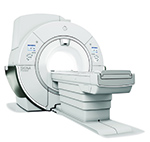3.0T MRI system
With up to twice higher signal levels than 1.5T systems, 3.0T MR systems improve spatial resolution and therefore provide more information on very fine anatomical structures. Typically, 3.0T MRIs are common in academic and research hospitals. Now the SIGNA Pioneer brings the power of 3.0T for clinical use and it is designed for accessibility to a broader range of healthcare providers. The SIGNA Pioneer 3.0T MRI delivers the ease-of-use and flexibility of a 1.5T system, with improved image homogeneity and reproducibility for oncology and spine imaging for example. In addition, ultra-high efficiency gradient technology enables high performance, even during demanding clinical applications such as cardiology or oncology. Using equivalent imaging parameters, physicians can use the signal gain to shorten patients’breath-holds for liver exploration; SIGNA Pioneer also enables free-breathing body imaging for a much improved patient experience but also image quality in very challenging situations. The new MAGiC sequence is a major innovation in neuroimaging enabling clinicians to generate six contrasts in a single scan and in as little as one-third of the total time taken to acquire each contrast separately using conventional techniques. After an acquisition of only approximately 5 minutes, it is now possible to adjust the image contrast in real time, even after completing the scan, by simply moving a dynamic cursor to change conventional MRI acquisition parameters (TE, TR and TI) depending on the disease or the age of the patient. MAGiC also provides quantitative information (maps T1, T2, and proton density) that opens new perspectives for the characterization and monitoring of lesions. This has the potential to provide physicians the ability to detect and characterize earlier and more precisely small or secondary lesions, improving the diagnosis and monitoring of patients with neurodegenerative disorders, and enabling the adjustment of the treatment of cancer patients. Patients with neurodegenerative disease, who cannot remain still during the examinations, can also now benefit from MR. With new advanced 3D motion correction software, SIGNA Pioneer will compensate patient movement to provide the same image quality and comfort for diagnosis despite involuntary movements. An enhanced SilentScan package also dramatically reduces scan noise from excess of 110 decibels (dBA) for conventional MRI scans to just three dBA above ambient noise for most head exams, a major differentiator for patient comfort and to minimize the risk of deteriorating image quality in anxious patients.


